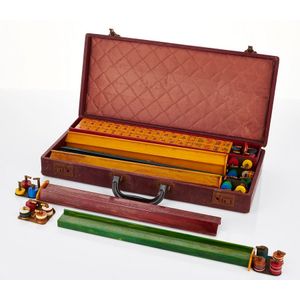Silver Cutlery Set with Oak Case and Stand
You must be a subscriber, and be logged in to view price and dealer details.
Subscribe Now to view actual auction price for this item
When you subscribe, you have the option of setting the currency in which to display prices to $Au, $US, $NZ or Stg.
- Marrow Spoon - A spoon with a long handle and a narrow scoop shaped bowl, used to scoop and eat marrow from the hollow centre of roasted bones. Some marrow scoops are double ended with a different shaped bowl at each end.
- Canteen - A small cabinet, table or a box with drawers or lift out trays, for storing a set of cutlery.
- Oak - Native to Europe and England, oak has been used for joinery, furniture and building since the beginning of the medieval civilisation. It is a pale yellow in colour when freshly cut and darkens with age to a mid brown colour.
Oak as a furniture timber was superceded by walnut in the 17th century, and in the 18th century by mahogany,
Semi-fossilised bog oak is black in colour, and is found in peat bogs where the trees have fallen and been preserved from decay by the bog. It is used for jewellery and small carved trinkets.
Pollard oak is taken from an oak that has been regularly pollarded, that is the upper branches have been removed at the top of the trunk, result that new branches would appear, and over time the top would become ball-like. . When harvested and sawn, the timber displays a continuous surface of knotty circles. The timber was scarce and expensive and was used in more expensive pieces of furniture in the Regency and Victorian periods. - Circa - A Latin term meaning 'about', often used in the antique trade to give an approximate date for the piece, usually considered to be five years on either side of the circa year. Thus, circa 1900 means the piece was made about 1900, probably between 1895 and 1905. The expression is sometimes abbreviated to c.1900.
This item has been included into following indexes:
Visually similar items

A traveling cash drawer, interior fitted and labelled for pre-decimal currency, circa 1900 A travelling cash drawer, interior fitted and labelled for pre-decimal currency, circa 1900 15 cm high, 34 cm wide, 30 cm deep

A fine quality silver-gilt dessert service for sixteen place settings in the stag pattern, London 1894-1906, by Goldsmiths and Silversmiths Company London in case

Mahjong set, in case. Provenance: The Estate of Dame Joan Alston Sutherland

Victorian figured walnut stationary box with hinged serpentine lid and fitted interior
